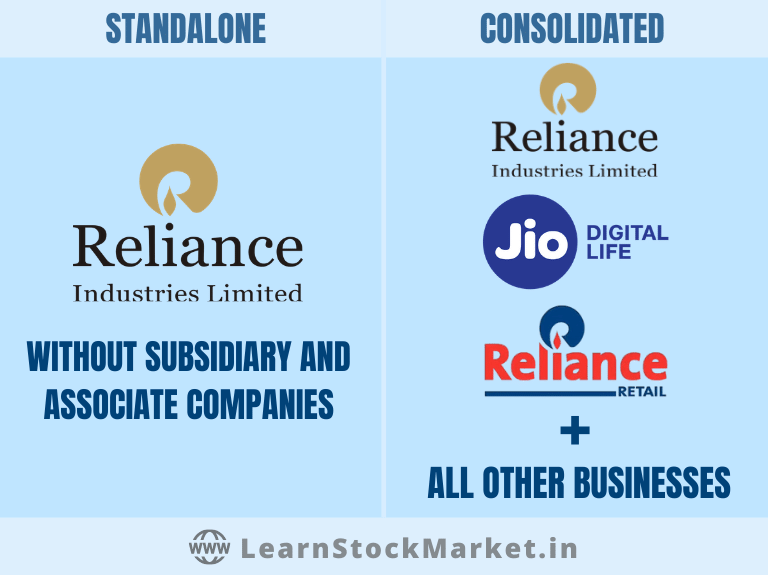A company releases financial results every 3 months. But did you know there are two types of results – Standalone and Consolidated.
Do you know the difference between Standalone and Consolidated?
If not, read on.
Standalone shows the financial performance of a company as a single entity.
Consolidated shows the financial performance of a company along with its subsidiary companies, associate companies and joint ventures.
Let’s take a real example to understand this better.
Reliance Industries is the main listed company of the Mukesh Ambani group.
‘Jio Platforms Ltd’ is a subsidiary of Reliance Industries. This company is India’s No 1 telecom player with more than 40 crore subscribers on the ‘Jio’ mobile network. It also handles all other digital business.
Similarly, ‘Reliance Retail Ventures Ltd’ is another subsidiary company of ‘Reliance Industries’. It’s the largest retailer in India, covering several categories like grocery and food items, apparel and footwear, electronic goods, home improvement etc.
When Reliance Industries releases its quarterly or annual results – the ‘Standalone results’ would only contain the financial performance of the core Reliance Industries business.
However, the ‘Consolidated Results’ would include its core business as well as ‘Jio Platforms’, ‘Reliance Retail Ventures’ and all its other subsidiaries and associate companies.

Do note, to keep the example simple and easy to understand – we have included only the popular companies of Reliance which everyone knows about. Reliance Industries is a large conglomerate. It has several companies under it. In fact, Reliance Retail itself has more divisions like Reliance Fresh, Reliance Smart, Reliance Digital etc.
The IPL team ‘Mumbai Indians’ is also a subsidiary company of Reliance Industries.
Back to the topic, the ‘Consolidated Profit and Loss Statement’ or ‘Consolidated Balance Sheet’ would always be more important than ‘Standalone’.
However, this need not always be true.
A company like ‘Info Edge’ has a highly-profitable standalone business – which is ‘Naukri.com’. But some of its other investments in companies like ‘Zomato’, ‘Policy Bazaar’ etc. have tremendous future potential – but at the moment, some companies are still not profitable.
So the ‘Standalone’ Profit and Loss statement of ‘Info Edge’ will look healthy – but ‘Consolidated’ may seem choppy or even loss-making.
This may not necessarily be a bad sign, as it’s a ‘debt free’ company with good amount of cash reserves. Also, it’s a technology company and some of its investments may not be profitable right now, but can help the company grow in the years to come. A company like Zomato is risky, but has tremendous potential.
Subsidiary Company
When a company holds more than 50% stake in another company, it becomes its subsidiary.
When the stake is 100%, it’s called a ‘wholly-owned subsidiary’.
For example, ‘Jio Platforms’ was a wholly-owned subsidiary of Reliance Industries. But recently, the company sold 9.99% of its stake to Facebook and 7.73% of stake to Google. It also sold its stake to a few other companies. Now, Reliance Industries owns 67.03% stake in Jio Platforms, making it a subsidiary company.
Another example – Larsen & Toubro (L&T) is the parent or holding company of ‘Mindtree’ because it owns 61.08% stake in the company. Mindtree is a ‘subsidiary’ of Larsen and Toubro Group.
Associate Company
When a company holds between 20% and 50% stake in another company, it becomes an associate company.
Do note, holding 50% stake is still an associate company. If it’s more than 50%, then it’s a subsidiary.


Appreciate it for helping out, excellent information.
No doubts about this article. It is simply awesome.
explained excellently
There is definately a great deal to know about this subject.
I really like all of the points you have made.
Its not my first time to pay a quick visit to this website, I am visiting this website daily and obtain nice facts from here daily.
Very good article! Keep up the good writing.
Very nicely explained
Excellent deliberations
Great article.
Great article. Simplified and to the point.
great .. very simple
What if a company holds less than 20% stake in other company? what do we call it then?
Really very good information for beginners to understand the company working style. Thanks a ton.
An interesting discussion is definitely worth comment.
I do think that you ought to publish more on this subject.
Thank you for the information provided. Crisp & clear information.
Great Article. Concepts are explained in very simple terms with examples
Very informative, simply explained without any unknown terms…
Great work…keep it up..with us..